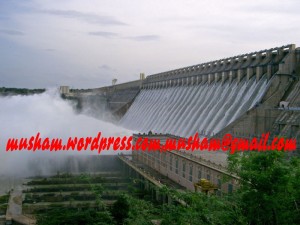NAGARJUNASAGAR DAM PLANNED FROM1903
The proposal to construct a dam to use the excess waters of the Krishna river was put forward by the British rulers in 1903.Siddeswaram and Pulichintala were identified as the suitable locations for the reservoirs
The dam water was released by the then Prime Minister’s daughter, Indira Gandhi in 1967. The construction of the dam submerged an ancient Buddhist settlement, Nagarjunakonda, which was the capital of the Ikshvaku dynasty in the 1st and 2nd centuries, the successors of the
Satavahanas in the Eastern Deccan. Excavations here had yielded 30 Buddhist monasteries, as well as art works and inscriptions of great historical importance. In advance of the reservoir’s flooding, monuments were dug up and relocated. Some were moved to Nagarjuna’s Hill, now an island in the middle of the reservoir. Others were moved to the mainland Nagarjuna Sagar Dam is the world’s largest masonry dam built across Krishna River in
Nagarjuna Sagar,Nalgonda District of Andhra Pradesh, India. It is downstream to the Nagarjuna sagar reservoir with a capacity up to 11,472 million cubic metres which is the world’s largest man-made lake with a concrete wall of 6 ft. thickness. The dam is 490 ft. tall and 16 Km long with 26 gates which are 42 ft. wide and 45 ft. tall.It is one of the earliest irrigation and hydro-electric projects in India. The dam provides irrigation water to the Nalgonda District, Prakasam District, Khammam District, and Guntur
The dam water was released by the then Prime Minister’s daughter, Indira Gandhi in 1967. The construction of the dam submerged an ancient Buddhist settlement, Nagarjunakonda, which was the capital of the Ikshvaku dynasty in the 1st and 2nd centuries, the successors of the
Satavahanas in the Eastern Deccan. Excavations here had yielded 30 Buddhist monasteries, as well as art works and inscriptions of great historical importance. In advance of the reservoir’s flooding, monuments were dug up and relocated. Some were moved to Nagarjuna’s Hill, now an island in the middle of the reservoir. Others were moved to the mainland Nagarjuna Sagar Dam is the world’s largest masonry dam built across Krishna River in
Nagarjuna Sagar,Nalgonda District of Andhra Pradesh, India. It is downstream to the Nagarjuna sagar reservoir with a capacity up to 11,472 million cubic metres which is the world’s largest man-made lake with a concrete wall of 6 ft. thickness. The dam is 490 ft. tall and 16 Km long with 26 gates which are 42 ft. wide and 45 ft. tall.It is one of the earliest irrigation and hydro-electric projects in India. The dam provides irrigation water to the Nalgonda District, Prakasam District, Khammam District, and Guntur
District.



No comments:
Post a Comment